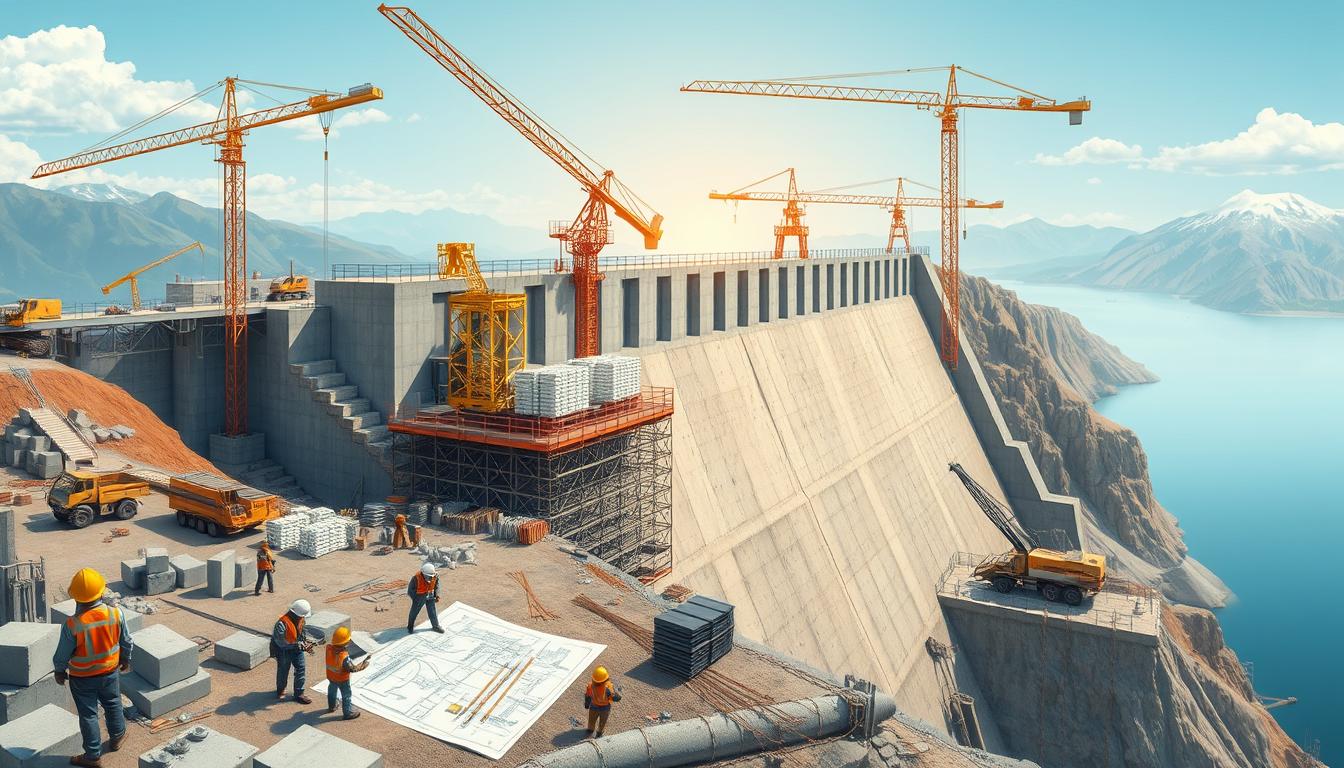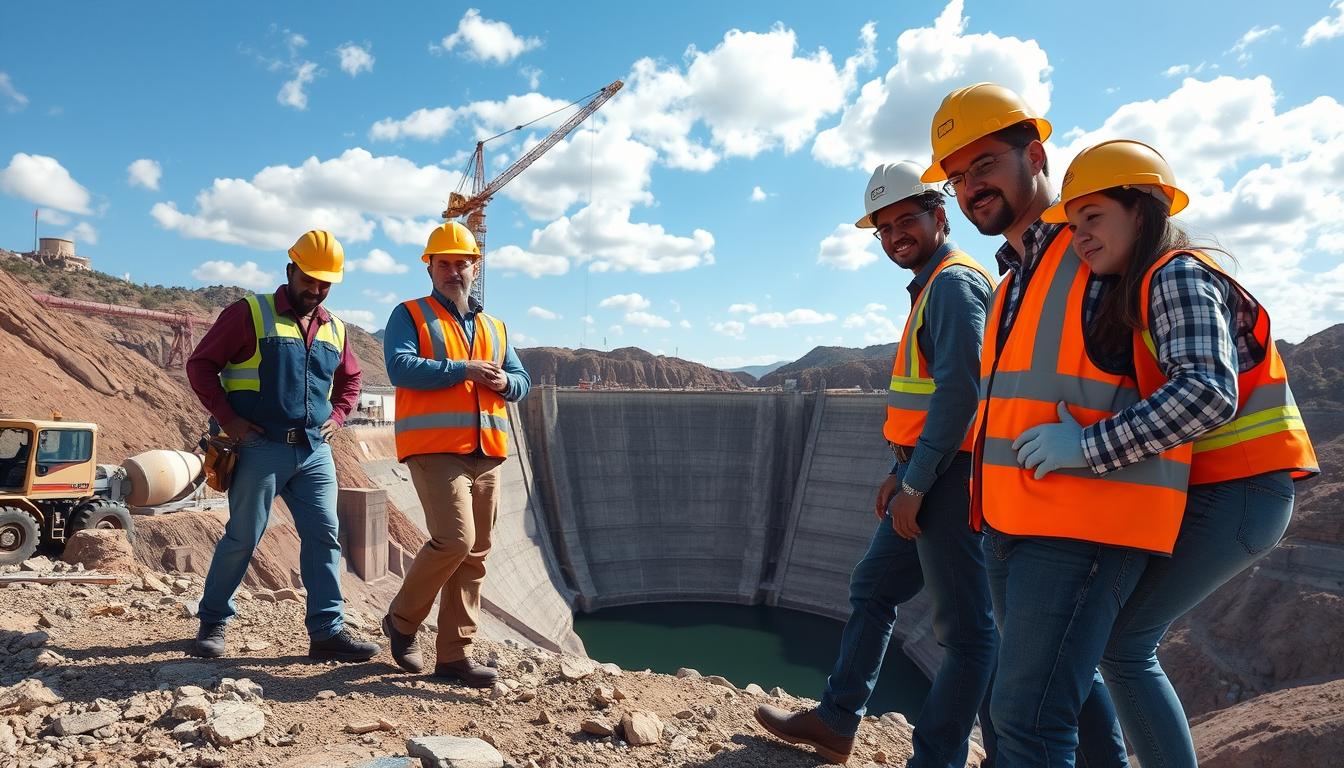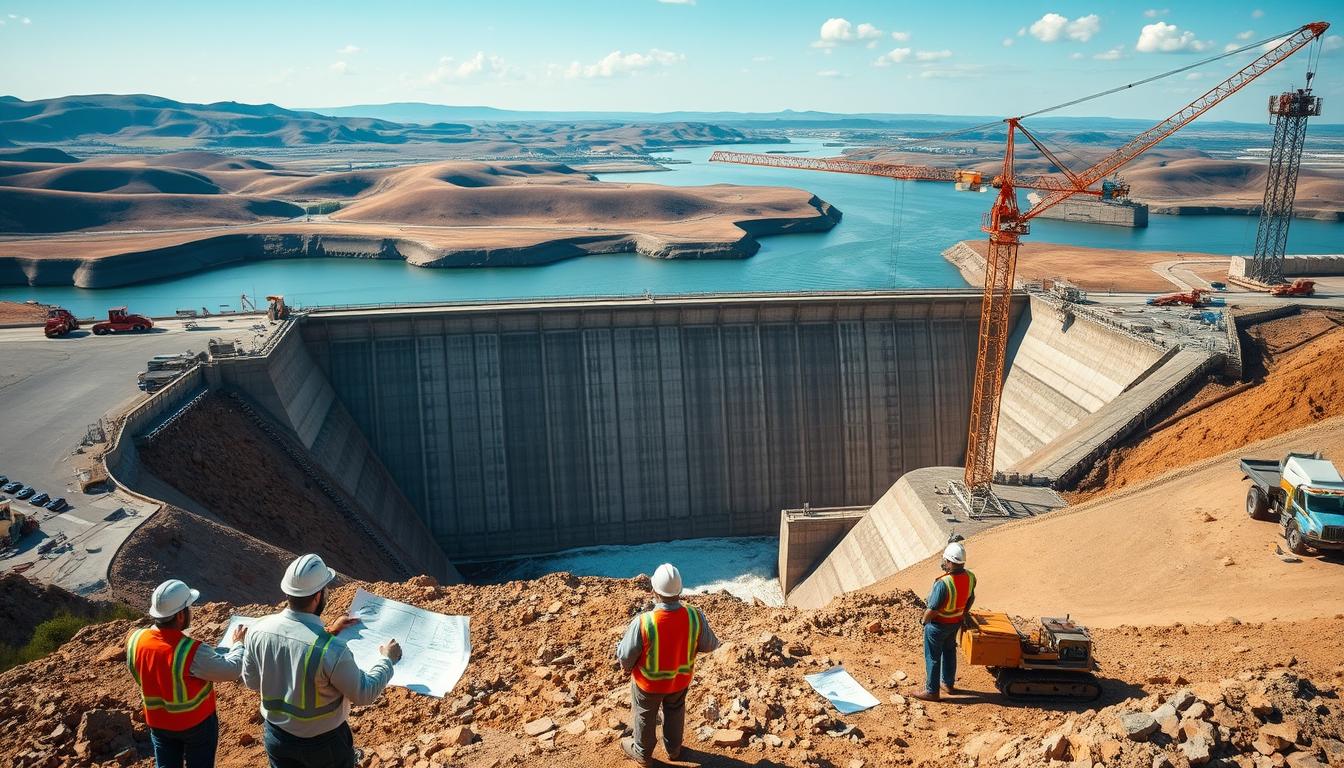How Much Money Is A Dam – Construction Cost Guide
> “The true measure of a man is not how he behaves in moments of comfort and convenience, but how he stands at times of challenge and controversy.” – Martin Luther King Jr.
Dams are huge projects that get a lot of attention and money. They help control floods, supply water, and make electricity. But, the cost to build a dam is complex and often not fully understood.
This guide will look into the costs of building dams. We’ll cover what affects the price, like the dam’s type and materials. We’ll also talk about environmental rules and keeping the dam running over time.
Key Takeaways
- Dam construction costs can vary widely depending on factors such as the type of dam, location, and environmental regulations.
- Understanding the fundamental components and cost drivers of dam projects is essential for stakeholders and investors.
- Careful site selection, environmental impact assessments, and compliance with regulatory requirements significantly impact the overall budget.
- Integrating hydroelectric power generation and considering long-term maintenance and operating expenses are crucial for project viability.
- Exploring diverse financing options and evaluating the long-term economic benefits can help optimize the return on investment for dam projects.
Understanding Dam Construction Fundamentals and Cost Factors
Building a dam is a complex task that needs a deep understanding of many factors. When looking at dam infrastructure investment, it’s important to know about different dams, their parts, and what affects their cost.
Types of Dams and Their Basic Components
Dams vary in size and shape, each for a specific purpose. From the grand concrete arch dams to the more affordable earthen embankment dams, the dam type greatly influences the dam budget analysis and dam economic feasibility.
- Concrete dams: Made of solid concrete, these dams are strong and last long.
- Earthen dams: Made of soil and rock, these dams are cheaper but need careful design and building.
- Gravity dams: These dams use their own weight to hold back water, a common choice for many projects.
- Arch dams: With a curved design, arch dams efficiently transfer water pressure to the abutments, ideal for narrow gorges.
Key Factors Influencing Construction Costs
The cost of building a dam depends on many things, from where to build it to environmental factors. Knowing these key points is vital for accurate dam budget analysis and ensuring the project’s dam economic feasibility.
- Site selection: The site’s topography, geology, and how easy it is to get to can greatly affect costs.
- Environmental impact assessment: Detailed studies and plans are needed to protect the environment.
- Material and equipment requirements: The materials and machines needed also play a big part in the cost.
- Labor and project timeline: The availability of skilled workers and how long the project takes can also affect the cost.
By understanding these basics, those involved in dam projects can make better decisions. This helps ensure their dam infrastructure investment is wise and successful in the long run.
“Proper planning and understanding of the construction fundamentals are essential for the successful and cost-effective implementation of any dam project.”
How Much Money Is A Dam: Breaking Down the Costs
Building a dam is a big and expensive job. It needs a lot of money. The cost depends on the dam’s type, size, where it’s built, and the project’s needs.
Dams are huge and need lots of materials like concrete and steel. They also require skilled workers and special machines. This makes the project very costly.
Another big factor is following environmental and legal rules. These rules add to the cost. They include doing environmental studies, getting permits, and fixing any problems.
To understand dam costs better, let’s look at what makes them expensive:
- Materials and Equipment: The cost of concrete, steel, and other materials. Also, the price of heavy machinery and equipment.
- Labor Costs: The money for workers’ wages and benefits. This includes engineers and project managers.
- Environmental Compliance: Costs for environmental studies, fixes, and following rules.
- Integration with Hydroelectric Power: If the dam makes electricity, adding power equipment costs extra.
- Maintenance and Operations: Costs for keeping the dam running. This includes regular checks, repairs, and staff.
Dam projects can cost from tens of millions to billions of dollars. Knowing what makes up these costs helps in planning and funding. This way, everyone involved can make better decisions.
Materials and Equipment Requirements for Dam Construction
Building a dam is a huge task that needs many specialized materials and equipment. The costs of these items are key to the dam’s budget and investment.
Concrete and Steel Specifications
Concrete and steel are the base of a dam. High-strength concrete, often with steel rods or fibers, is vital for the dam’s strength and lasting power. The exact amount and type of these materials greatly affect the budget.
Heavy Machinery and Specialized Equipment
- Excavators, bulldozers, and other heavy equipment are needed for site preparation and earthmoving.
- Specialized machinery, such as concrete pumps, cranes, and pile drivers, are crucial for the actual construction process.
- The rental or purchase of these heavy-duty machines can be a significant portion of the overall dam building expenses.
Transportation and Logistics Expenses
Getting all the materials and equipment to the dam site is a big cost. This includes trucks, trains, and barges, plus fuel and labor. Good planning and efficient transport can help manage costs.
| Material/Equipment | Estimated Cost Range |
|---|---|
| Concrete (per cubic yard) | $80 – $150 |
| Steel Rebar (per ton) | $800 – $1,200 |
| Excavator Rental (per day) | $300 – $500 |
| Concrete Pump Rental (per day) | $500 – $800 |
| Truck Transportation (per mile) | $2 – $4 |
The costs of materials, equipment, and logistics are big parts of a dam’s budget. Knowing these costs helps plan and budget better for a successful dam project.
Labor Costs and Project Timeline Considerations
Labor costs are a big part of dam construction cost. The project needs skilled workers like civil engineers and construction workers. They all add to the budget. Managing the workforce well helps keep costs down and finishes the project on time.
The dam project financing plan must include labor costs. This includes wages, benefits, and training. The project’s timeline also affects costs. Longer projects mean more expenses for salaries, overtime, and equipment.
To analyze the dam budget right, consider these points:
- Skilled labor needs, like engineers and technicians
- Competitive wages and benefits to keep good workers
- Overtime pay and shift work for busy times
- Training to keep the workforce ready
- Good scheduling to avoid downtime and boost productivity
By planning labor costs well, dam projects can meet their deadlines and budgets. This makes the investment more financially sound.
| Labor Cost Category | Estimated Range |
|---|---|
| Civil Engineers | $80,000 – $120,000 per year |
| Construction Workers | $40,000 – $60,000 per year |
| Project Managers | $100,000 – $150,000 per year |
| Specialized Technicians | $60,000 – $90,000 per year |
These are just estimates and can change based on many factors. Good budgeting and planning are key to managing dam construction cost well.
Environmental Compliance and Permitting Expenses
Building a dam is a complex task. It involves many environmental rules and permits. These steps can greatly affect the dam economic feasibility, adding a lot to the project’s budget.
Regulatory Requirements
Dam projects must follow many environmental laws. This includes the Clean Water Act and the Endangered Species Act. Getting the needed permits takes time and money. It involves detailed environmental studies, public meetings, and approvals from agencies.
Environmental Mitigation Measures
- Restoring or protecting habitats affected by the dam
- Implementing measures to minimize the impact on wildlife and ecosystems
- Developing plans for the management of water quality, sediment, and other environmental factors
These steps are crucial but can increase the project’s costs. They are especially important in areas that are sensitive or protected.
Compliance Monitoring Costs
After the dam is built, it must be monitored to follow environmental rules. This includes regular checks, water tests, and fixing any problems. These costs keep adding up, affecting the dam economic feasibility and dam capital expenditure.
Dealing with environmental rules is key for dam projects. Knowing and planning for these costs is vital. It helps make sure the project is economically sound and sustainable in the long run.
Hydroelectric Power Integration Costs
Building a dam means adding hydroelectric power generation. This part of the project can greatly affect the budget. Knowing the costs is key for planning and making decisions.
Adding hydroelectric power to a dam involves several costs. These include:
- Turbines and generators: The special equipment needed to turn water into electricity.
- Electrical transmission infrastructure: Building power lines, substations, and more to send electricity to the grid.
- Control systems and monitoring equipment: Advanced tech to manage and improve power generation.
- Specialized engineering and technical expertise: Hiring skilled people to design, install, and maintain the system.
The costs for these parts can change a lot. They depend on the dam’s size, complexity, site conditions, and rules. Bigger dams cost more, with prices from tens of millions to hundreds of millions of dollars.
| Component | Estimated Cost Range |
|---|---|
| Turbines and Generators | $20 million – $100 million |
| Electrical Transmission Infrastructure | $10 million – $50 million |
| Control Systems and Monitoring | $5 million – $20 million |
| Engineering and Technical Expertise | $2 million – $10 million |
The initial costs of adding hydroelectric power are high. But, the long-term benefits make it worth it. Dams can provide stable, clean energy and help with flood control and water management.
“The integration of hydroelectric power generation is a critical component of modern dam infrastructure, unlocking the immense potential of our natural water resources.”
Maintenance and Operating Cost Projections
Keeping a dam running is a big job that needs good financial planning. The dam maintenance expenditure and dam capital outlay can be big costs. Knowing these costs is key for dam owners and investors to make smart choices.
Regular Maintenance Requirements
Dams need regular checks, fixes, and care to stay strong and work right. This includes tasks like:
- Clearing debris and sediment from the reservoir and spillways
- Repairing concrete structures and reinforcing materials
- Maintaining mechanical and electrical components
- Upgrading safety and monitoring systems
These regular tasks can take up a big part of the dam’s budget.
Emergency Repair Provisions
Dam owners also need to plan for emergencies. Things like floods, earthquakes, or structural failures might need quick and expensive fixes. It’s important to set aside money for these emergency repairs to keep the dam safe and running.
Staff and Training Expenses
Running a dam needs a skilled team. Dam owners must plan for the salaries and training of workers, like engineers and technicians. Keeping staff up-to-date with training helps them handle the complex tasks of dam management.
Good budgeting and planning are key to figuring out the dam maintenance expenditure, dam capital outlay, and dam project budget for the long haul. By understanding these costs, dam owners can make smart choices and keep their dams working well for a long time.
Financing Options and Investment Strategies
Building a dam is a huge task that needs a lot of money. But, there are many ways to get the funds needed for dam projects. Knowing these options is key to finishing dam projects well.
One big dam financing source is government money through grants and subsidies. Many governments help fund dams for power, water, or flood control. This money can help cover the big costs of dam projects.
- Government funding can lessen the financial load on dam projects.
- Private money and dam project financing like partnerships or bonds are also options. They can help get the funds needed.
New ways like public-private partnerships (PPPs) are also good for dam financing sources. These partnerships mix public and private money. They share the risks and rewards of dam projects.
| Financing Option | Key Advantages | Potential Drawbacks |
|---|---|---|
| Government Grants |
|
|
| Private Investment |
|
|
| Public-Private Partnerships |
|
|
By looking into different dam financing sources and plans, project teams can make a solid funding plan. This plan will cover the big costs of building and keeping dams.
“Getting the right money is key to finishing a dam project. It’s important to look at many funding options and make a plan that fits the project’s needs.”
Long-term Economic Benefits and ROI Analysis
Dams are key for long-term economic gains and return on investment (ROI). They offer hydroelectric power, water management, and flood control. These benefits make dams valuable for communities and regions.
Energy Generation Revenue
Dams generate electricity through hydropower, a clean, renewable energy source. This electricity can be sold to the grid, creating a steady income. The cost of building a dam can be offset by this income, making it a good investment.
Water Supply Benefits
Dams help manage water resources, providing a steady water supply for various uses. This can boost agricultural productivity and ensure water for homes and businesses. It also reduces the need for expensive water transport, adding to the dam’s economic value.
Flood Control Value
Dams also protect against floods by controlling water flow. This saves communities from flood damage, reducing property loss and saving lives. It also cuts down on disaster response and recovery costs, making dams a wise investment.
By examining these benefits, dam planners and investors can understand their long-term ROI. This approach helps recognize dams’ true value in decision-making.
| Economic Benefit | Description | Contribution to ROI |
|---|---|---|
| Energy Generation Revenue | Income from selling hydroelectric power to the grid | Significant |
| Water Supply Benefits | Reliable water for municipal, agricultural, and industrial use | Substantial |
| Flood Control Value | Reduced property damage and disaster response costs | Considerable |
Conclusion
Building a dam is a complex task that needs careful planning and budgeting. The cost of a dam project changes based on many factors. These include the dam’s type, size, location, and environmental impact.
For a dam project to succeed, it’s crucial to understand the basics of construction. You also need to know about materials, equipment, labor costs, and following rules. It’s also important to think about using hydroelectric power and the costs of upkeep over time.
In the United States, there’s a growing need for better water infrastructure and renewable energy. This means more dam projects are needed. By understanding the costs and planning well, we can make sure these projects work out in the long run.
FAQ
What are the different types of dams and their basic components?
Dams vary, like gravity, arch, and embankment dams. Each has its own design and needs. A dam usually has a foundation, abutments, spillway, intake, and powerhouse for power.
What are the key factors that influence the construction costs of a dam?
Several things affect dam construction costs. These include the dam’s size, type, and the terrain. Also, material availability, labor costs, and environmental rules matter.
How do site selection and environmental impact assessments affect the overall cost of a dam project?
Choosing the right site and assessing its environmental impact are key. Geology, accessibility, and ecosystem impact affect costs. This includes site prep, mitigation, and ongoing monitoring.
What are the major cost components involved in dam construction?
Major costs include materials, machinery, labor, and transportation. Also, environmental compliance and permits add to the cost.
How do labor costs and project timelines affect the overall budget for a dam project?
Labor costs, like salaries, are big. The project’s length also affects costs. Longer projects need more people, raising expenses.
What are the environmental compliance and permitting costs associated with dam construction?
Dam projects need environmental studies and permits. These costs include studies, permits, and monitoring. They add to the project’s budget.
How do the costs of integrating hydroelectric power generation capabilities into a dam project compare to a non-power dam?
Adding power generation costs more for equipment and expertise. But, it can pay off with electricity sales over time.
What are the ongoing maintenance and operating costs associated with a dam?
Dams need regular checks and repairs. Costs include staff, training, and upkeep. Accurate long-term cost projections are key for a dam’s financial success.
What financing options and investment strategies are available for dam projects?
Dam projects can get funding from public, private, and government sources. Understanding these options is crucial for securing funds.
What are the long-term economic benefits and potential return on investment (ROI) from a dam project?
Dams offer long-term benefits like power, water, and flood control. These benefits, along with costs, determine the ROI. This makes dams a good investment for communities and economies.





